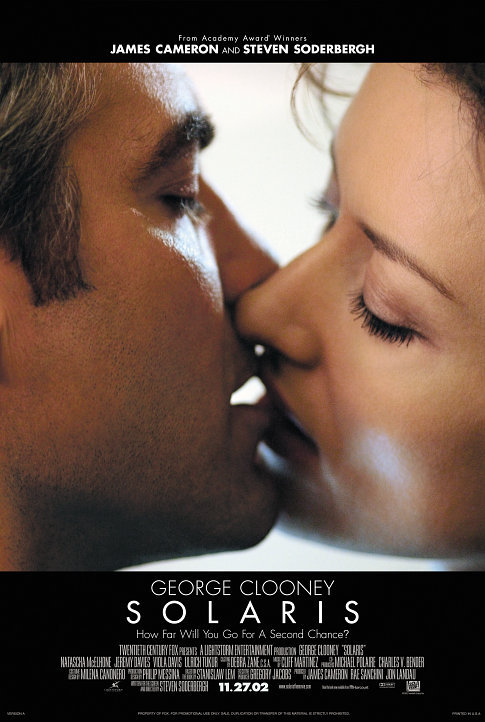Solaris review by Jackass Tom
Too much romance
The last film that Steven Soderburgh remade was Ocean’s 11 which, in my humble opinion, he improved on greatly. The original was outdated and filled with Rat Pack acting i.e. bad acting. Frank Sinatra was replaced with George Clooney and ‘POOF!’ we have a better movie. But seriously, the first movie wasn’t anything to write home about. With Solaris Soderburgh decided to bite on a bigger cookie and, understandably, it was too much for him to chew. The original Solaris was done by Russian director Andrei Tarkovsky. Tarkovsky was Russia’s Kubrick in many ways. He used slow pacing to create tension and realism and in his almost 30 year career he directed only a small number of films (I heard seven on TCM but I see 5 on IMDB). His films are also very deep and philosophical, often mocking the Soviet government that ironically allowed his movies to be produced. When you are the best, you can get away with a little pot-shot every now and then. Solaris itself is often compared to Kubrick’s 2001. Its slow pace is hardly the norm for a sci-fi film, but its deep mysterious meaning gets closer and closer with each viewing but is still too far away to grasp consciously. Soderburgh’s version, while at times entertaining, lacks this effect and ends up seeming like an average film.
The movie starts on Earth in the future sometime. George Clooney plays troubled psychologist Chris Kelvin who is summoned to access and salvage the mission of a near abandoned space station orbiting the ocean planet Solaris. Kelvin became the man for the job when one of the few messages sent from the ship was addressed to him. When he gets there he finds cold bodies and babbling mad scientists with vague answers. When Kelvin wakes up in the morning he finds his formerly dead wife Raya (Natasha McElhone) alive and well by his side.
MINOR SPOILIERS IF YOU CARE!!!
It is theorized by the scientists that the planet reads the minds of the people on the ship and creates a replica of the person they desire (a brother, a wife, a son, etc.). The passengers of the spaceship began to lose their sanity when they couldn’t control reality. Some killed themselves, and others killed some. It is uncertain why the planet was doing this or whether it ‘wanted’ something from the people on board.
The replicas Solaris created are not exact in everyway; one of the neat hitches of the movie is that they are created out of your memory and not from the actual person. There are noticable dramatic differences in personality between Raya in her replica form and the real Raya in Kelvin’s frequent flashbacks (often occurring during the dream sequences). The true Raya was a free-spirit and had a touch of wild bohemian attitude. Oddly she was the one who didn’t give in quickly to Kelvin’s marriage proposals in fear of losing her youthful freedom. Her allure was her playful persistence to not give in easily. In contrast, her replica was submissive and helpless when stranded by Kelvin. Natasha McElhone did a superb job creating a distinction between the two (I was even told that her make was different; a little les aggressive if you will).
For women looking for skin, George Clooney bares his butt. Twice. Not exactly my cup of java, but its there if you want it. Its also there if you don’t want it so you gotta live with it.
Also of note is Jeremy Davies who plays a whacked out scientist on the space station. His character is derived Dennis Hopper’s photographer in Apocalypse Now with two scoops of Lumberg from Office Space. George Clooney’s straight questions to him are often answered with long, drawn out, incoherent thoughts that end with more confusion than answers. He has some moments of oddball comedy in this film, but that doesn’t hide that fact that I can’t look at the guy without thinking “Doogie Howser look alike.”
After the first hour, it is obvious this movie takes the easy way out when it comes to ‘meaning.’ Instead of focusing on underlying themes, questions with no answers, and rebellious political references like the original, Soderburgh focuses more on the relationship that was lost, regained, lost again, regained, etc. between Kelvin and Raya. Solaris of 2002 ends up being nothing more than a tragic romance set in what could be a thought provoking sci-fi film. On the plus side, the settings in the film are well done without being Speilberg flashy. Afterall, Soderburgh works on a budget. And leave it to Soderburgh to create some beautiful camera shots, and mix them staggeringly with the soundtrack. Its now an official Soderburgh trademark to have disjointed voices hanging onto to shots that are 3-5 seconds behind the soundtrack. This trick fleshes out the humanity of the actor’s who are still on camera while offering an indirect commentary through the dialogue. Its all fine and dandy, but unfortunately doesn’t make up for the fact that this is just an average romance dressed up like something deeper.





5 out of 10 Jackasses blog comments powered by Disqus
